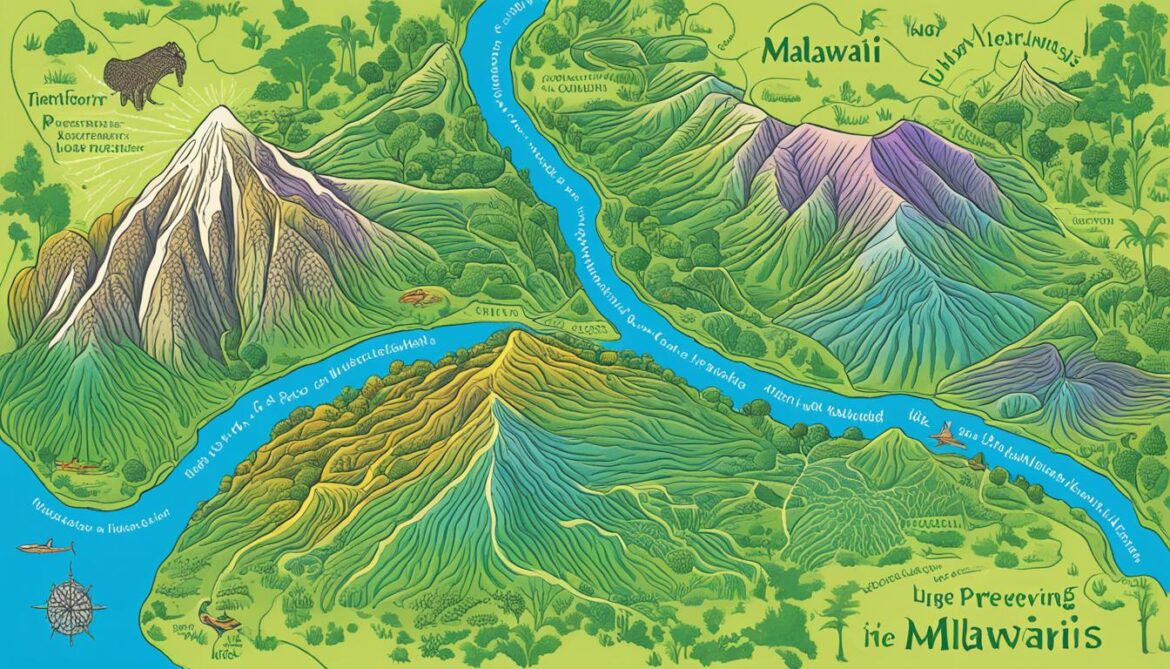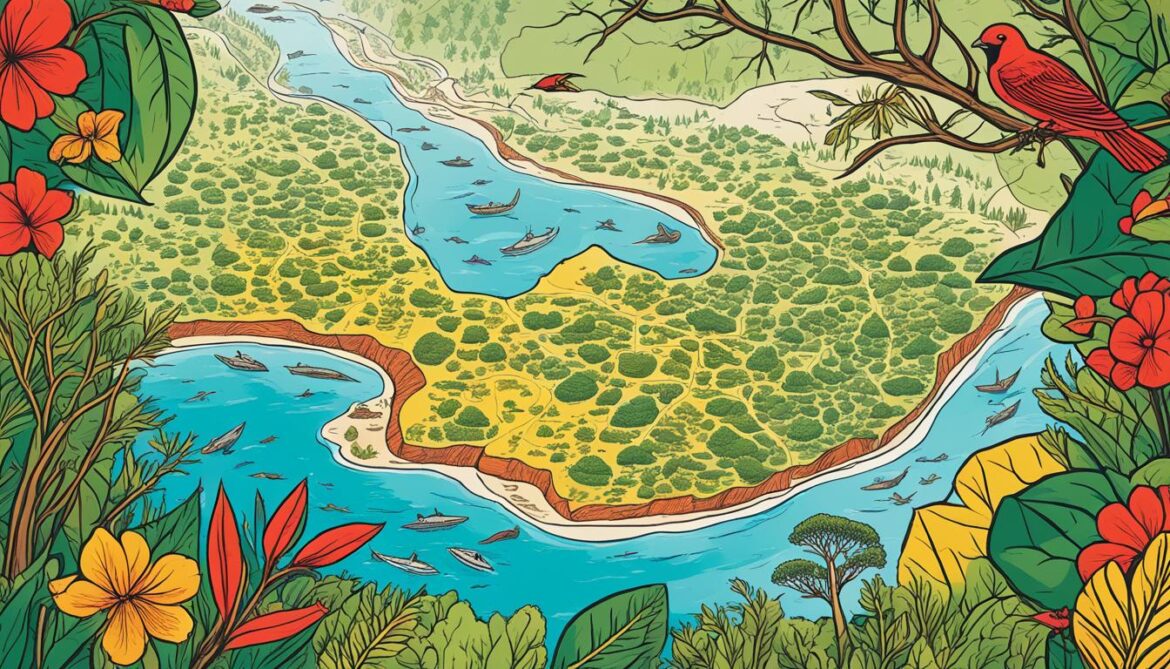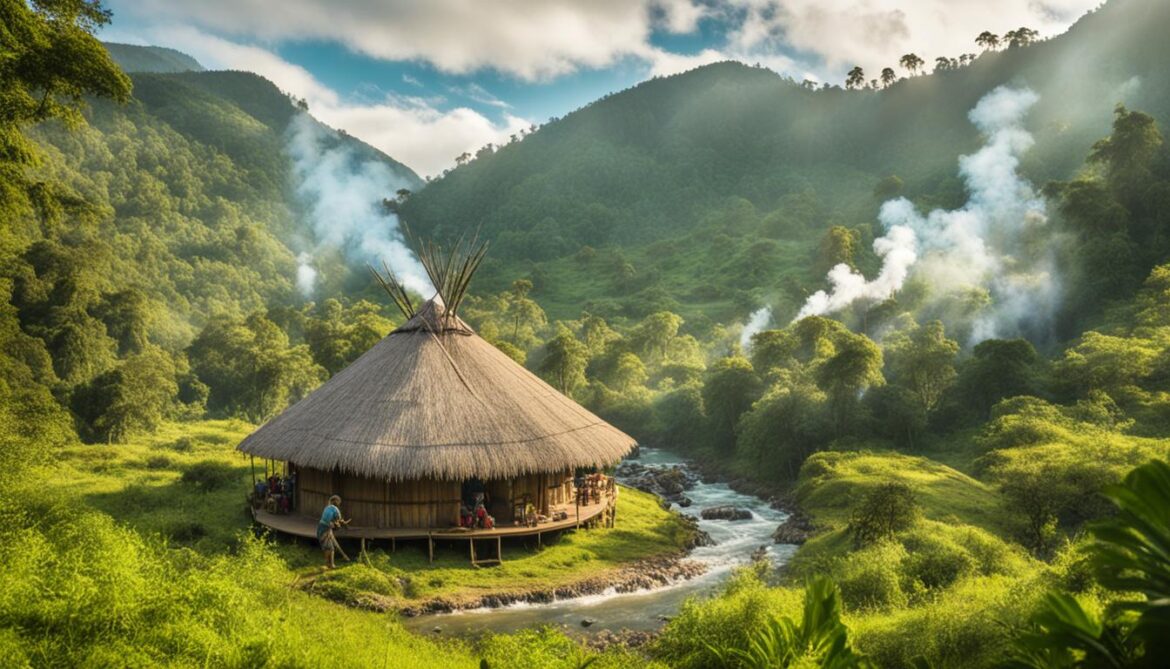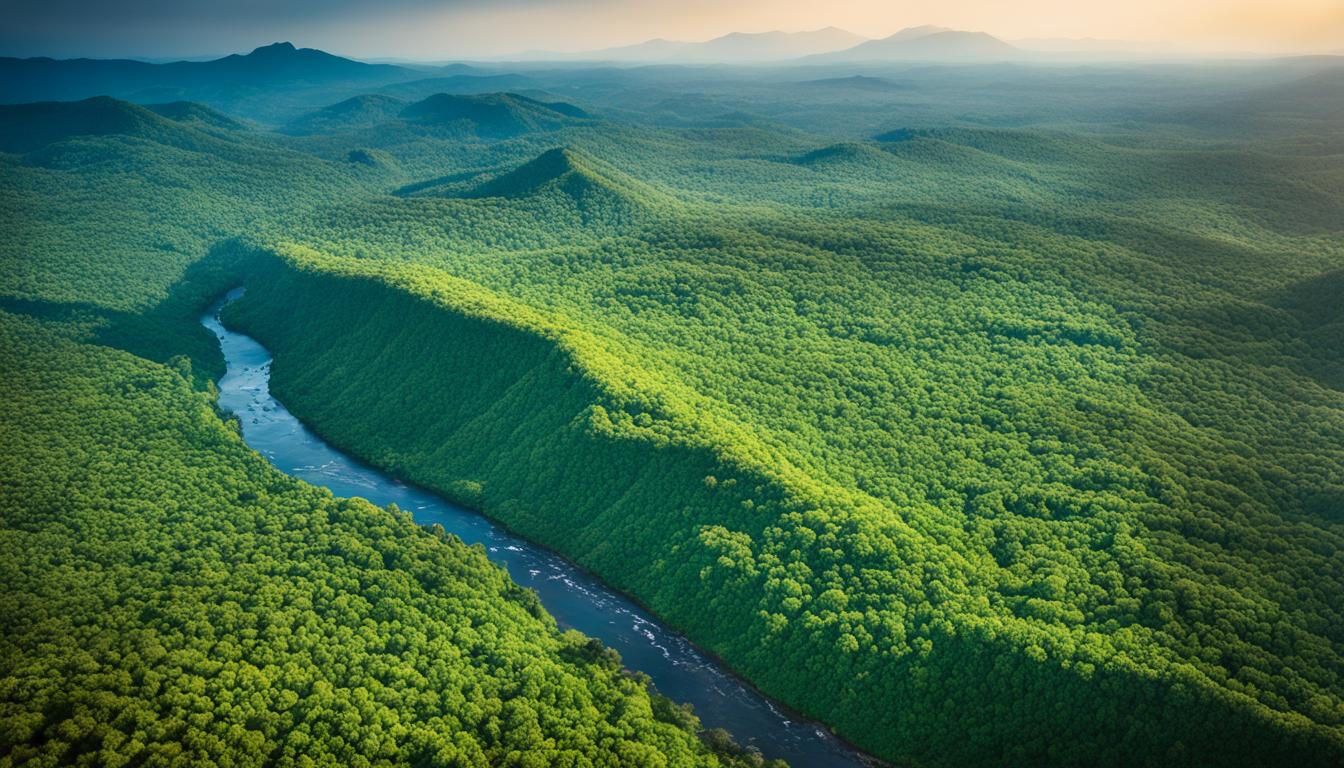Did you know that sacred shrines and sites have existed in Malawi since 1500 A.D? These sites, scattered throughout the country, hold immense cultural and spiritual significance for the local communities. They not only serve as places of worship but also play a crucial role in the preservation of indigenous knowledge and traditions. Let’s explore the fascinating world of Malawi’s sacred natural sites and their contribution to biodiversity conservation.
Key Takeaways:
- Malawi has had sacred shrines and sites since 1500 A.D., which hold cultural and spiritual significance.
- Khulubvi Sacred Shrine is a major spiritual site for the Mang’anja tribe.
- Sacred sites associated with Mbona worship contribute to the preservation of indigenous knowledge and traditions.
- Malawi’s sacred natural sites have social, cultural, historical, and scientific value.
- Local communities play a crucial role in preserving the authenticity and integrity of these sites.
The Significance of Khulubvi Sacred Shrine
The Khulubvi Sacred Shrine holds immense cultural and spiritual significance for the Mang’anja tribe in the Nsanje District of Malawi. This sacred site is believed to be the final resting place of Mbona, a revered figure with supernatural powers. People from the local community and beyond visit this shrine periodically to pay homage to Mbona and seek his intervention during times of adversity, such as drought, disease, and other calamities.
Located within the Khulubvi natural thicket, this sacred site is more than just a spiritual place. It also plays a crucial role in the preservation of traditional conservation practices in Malawi. The shrine consists of a traditional hut, which is a testament to the cultural heritage and reverence for nature within the Mang’anja tribe. The natural thicket surrounding the shrine is protected and serves as a reminder of the importance of safeguarding the environment.
This sacred site serves as a bridge between the spiritual and the natural world, reinforcing the deep connection between the Mang’anja tribe and their surrounding ecosystem.
By preserving the Khulubvi Sacred Shrine and its surrounding environment, the local community demonstrates their commitment to traditional conservation practices. This includes the prohibition of encroachment, destruction of vegetation, and hunting within the sacred thicket. The preservation of this site not only ensures the continuity of spiritual practices but also contributes to the broader goal of conserving Malawi’s natural resources.
The Khulubvi Sacred Shrine stands as a testament to the rich cultural heritage and ecological wisdom of the Mang’anja tribe. Its existence serves as an important reminder of the interconnectedness between sacred sites, traditional practices, and the preservation of Malawi’s natural heritage.
Traditional Conservation Practices at Khulubvi Sacred Shrine
| Conservation Practices |
Description |
| Sacred Thicket Protection |
Strict prohibitions against encroachment, destruction of vegetation, and hunting within the sacred thicket. |
| Traditional Hut |
The traditional hut within the shrine symbolizes the cultural significance and reverence for nature. |
| Spiritual Practices |
Rituals and ceremonies conducted at the shrine reinforce the importance of preserving the environment. |
Associated Sacred Sites
In addition to the Khulubvi Sacred Shrine, Malawi is home to several other sacred sites that are associated with the worship of Mbona. These sites include:
- Nyandzikwi sacred site
- Mwala U1I1odzi shrine
- Kaloga sacred cave site
- Chifunda Lundu
- Nkhadzi sacred site
These sacred sites serve as spiritual pathways for Mbona and act as locations where sacrifices are offered to alleviate sickness, misfortunes, and environmental challenges. Situated within dense forests, these sites hold significant indigenous knowledge that contributes to biodiversity conservation in Malawi. They are also rich sources of medicinal plants, adding to their ecological importance.
“The sacred sites associated with Mbona worship in Malawi are not only places of spiritual significance but also hold valuable knowledge about the local biodiversity. Preserving these sites ensures the continuity of both cultural traditions and ecological balance.” – Dr. Grace Banda, Environmental Scientist

Sacred Site Comparison:
Let’s compare the characteristics of these sacred sites:
| Sacred Site |
Location |
Significance |
| Nyandzikwi sacred site |
Chiradzulu District |
Associated with the healing and fertility rituals |
| Mwala U1I1odzi shrine |
Ntcheu District |
Believed to possess powers to protect the community from evil spirits |
| Kaloga sacred cave site |
Karonga District |
A sacred cave used for rituals and spiritual ceremonies |
| Chifunda Lundu |
Nkhata Bay District |
Regarded as the residence of a spirit associated with rainmaking |
| Nkhadzi sacred site |
Nkhotakota District |
Worshipped for the purpose of protection and divine intervention |
These sacred sites are important cultural and spiritual landmarks in Malawi, contributing to the country’s rich biodiversity conservation efforts while preserving indigenous knowledge.
Values of Sacred Natural Sites
The sacred natural sites in Malawi hold various values, including spiritual, social/cultural, historical, and scientific significance. These sites serve as places for traditional religious practices, fostering a sense of community and cultural identity. They attract people from different cultures and facilitate the expression of traditional practices, strengthening the connection between individuals and their shared heritage. The existence of traditional ceremonies at these sites adds to the historical narrative of Malawi, preserving age-old traditions for future generations.
The Spiritual Significance
These sacred natural sites in Malawi hold significant spiritual value for the local communities. They are considered sacred places where individuals can connect with the divine and seek solace, guidance, and blessings. The serene environments of these sites create a peaceful atmosphere, conducive to spiritual reflection and worship.
“The sacred natural sites offer a sanctuary for spiritual solace and connection with our ancestors and deities.” – Local Elder
The Social and Cultural Importance
These sites play a crucial role in fostering social cohesion and cultural preservation. They serve as gathering places for ceremonies, festivals, and rituals, where communities come together to celebrate, honor their traditions, and pass down cultural knowledge to younger generations. The shared experiences at these sacred sites strengthen the bond between community members and reinforce their collective identity.
- The annual Mbona Festival held at Khulubvi Sacred Shrine brings together people from various cultural backgrounds, promoting cultural exchange and understanding.
- The sacred natural sites serve as venues for traditional dances, music performances, and storytelling, keeping the cultural heritage alive.
- Local artisans create crafts and artifacts inspired by the spiritual and cultural significance of these sites, preserving traditional craftsmanship.
The Historical and Ancestral Narratives
These sacred sites embody the historical and ancestral narratives of Malawi. They hold ancient stories, legends, and beliefs that provide a glimpse into the rich tapestry of the country’s past. By preserving and revering these sites, the local communities uphold their heritage and ensure that the stories of their ancestors are passed down through generations.
“Our sacred natural sites hold the wisdom of our ancestors and the stories of our people. They remind us of our roots.” – Local Historian
The Scientific Contribution
From a scientific perspective, these sacred natural sites contribute to the preservation of biodiversity and the understanding of local ecosystems. The dense vegetation and undisturbed habitats surrounding these sites provide a sanctuary for numerous plant and animal species, some of which may be endangered or unique to the region. Research conducted in these areas also aids in the discovery of new species and the study of traditional medicinal plants.
Preserving the Treasures of Malawi
The values associated with the sacred natural sites in Malawi extend beyond the spiritual and cultural realm. These sites contribute to the ecological and scientific wealth of the country, making their preservation crucial for future generations. By recognizing and protecting these sacred sites, Malawi can ensure the conservation of its diverse ecology, cultural landscapes and promote a sustainable future.
Authenticity and Integrity of the Sacred Sites
The sacred sites in Malawi, including Khulubvi Sacred Shrine, have maintained their authenticity and integrity over time. The local communities play a crucial role in preserving the sites and adhere to traditional norms and beliefs when conducting rituals and ceremonies. The sacred thicket of Khulubvi remains protected, with strict prohibitions against encroachment, destruction of vegetation, and hunting. The sites are managed by local elders and chiefs, who ensure that the original form and cultural values are maintained, contributing to the preservation of sacred forests in Malawi.
Preservation by the Local Communities
The preservation of sacred sites in Malawi is primarily driven by the local communities who have a deep-rooted connection to these sacred places. Through their collective efforts and adherence to traditional practices, the sites have been safeguarded from external threats and detrimental activities.
“Preserving the integrity of our sacred sites is at the core of our cultural heritage. We are committed to maintaining the sanctity of these places and passing on the legacy to future generations.”
Local elders and chiefs hold significant roles in the management and protection of these sites. They ensure that only authorized individuals are granted access, and strict guidelines are followed during rituals and ceremonies. This approach ensures that the original form and cultural values of the sacred sites are maintained.
Prohibitions and Conservation Practices
One of the key strategies in preserving the authenticity and integrity of the sacred sites is the implementation of strict prohibitions. These prohibitions serve as guidelines for the behavior and actions of visitors, emphasizing the importance of respecting the cultural and natural values associated with the sites.
The sacred thicket of Khulubvi, for example, has specific regulations in place to protect the surrounding forest. These regulations prohibit encroachment, destruction of vegetation, and hunting within the sacred area. By enforcing these prohibitions, the local communities ensure the preservation of sacred forests and the diverse ecosystems they support.
Moreover, the conservation practices employed by the local communities contribute to the overall protection of these sacred sites. Traditional knowledge and techniques are passed down through generations, ensuring that sustainable practices are maintained. This indigenous wisdom plays a vital role in the long-term preservation of both the sacred sites and the surrounding natural environment.
The Role of Sacred Forests in Conservation
The preservation of sacred forests in Malawi, as exemplified by Khulubvi Sacred Shrine, goes beyond cultural and spiritual significance. These forests harbor unique ecosystems that support a rich diversity of plant and animal species. They serve as sanctuaries for rare and endangered species, providing crucial habitats for their survival.
By protecting the integrity of the sacred sites and their surrounding forests, Malawi ensures the conservation of its biodiversity. These biodiverse ecosystems contribute to the overall health and resilience of the natural environment, promoting sustainable development and safeguarding the ecological balance for future generations.

Comparative Table of Sacred Sites Management
| Sacred Site |
Management Approach |
| Khulubvi Sacred Shrine (Malawi) |
Managed by local elders and chiefs, enforcing strict prohibitions against encroachment, destruction of vegetation, and hunting. |
| Mijikenda Sacred Forests (Kenya) |
Managed by community-based organizations and local authorities, promoting sustainable livelihoods and environmental conservation. |
| Osun Sacred Grove (Nigeria) |
Managed by traditional authorities, community organizations, and government agencies, implementing conservation measures and cultural preservation programs. |
The comparative table above highlights the various approaches to sacred sites management in different countries. While the specific strategies may vary, the common goal is the preservation of cultural heritage, biodiversity, and sustainable practices.
Comparison with Similar Properties
The Khulubvi Sacred Site in Malawi is not the only cultural and spiritual landmark of its kind. It shares many similarities with other World Heritage Sites, such as the Mijikenda Sacred Forests in Kenya and the Osun Sacred Grove in Nigeria. These sites, like Khulubvi, have been recognized for their unique contributions to traditional practices and the preservation of cultural heritage.
Malawi’s commitment to preserving sacred sites is reflected in these comparable properties, which are also considered cultural landscapes. Each site holds immense significance to the local communities and plays a vital role in maintaining cultural traditions and promoting understanding and respect for the past.
“Khulubvi, the Mijikenda Sacred Forests, and the Osun Sacred Grove are all living testaments to the importance of conserving Malawi’s cultural landscapes and upholding the values they represent. These sites allow us to connect with our ancestors, preserve our indigenous knowledge, and pass it on to future generations.”
While the Mijikenda Sacred Forests and Osun Sacred Grove are renowned for their historical and spiritual significance, Khulubvi stands out for its distinct form, setting, and the ongoing tradition of Mbona worship. It’s a testament to the rich cultural diversity found throughout Southern Africa and the importance of conserving Malawi’s sacred sites.
Similarities and Contrasts:
| Property |
Country |
Features |
| Mijikenda Sacred Forests |
Kenya |
The Mijikenda Sacred Forests, located in the coastal region of Kenya, are a network of sacred forests and shrines. They are considered sacred by nine Mijikenda tribes and serve as places of cultural and spiritual significance. |
| Osun Sacred Grove |
Nigeria |
The Osun Sacred Grove, situated on the outskirts of Osogbo, is dedicated to the Yoruba goddess Osun. The grove encompasses a river, forest, and a series of shrines, and it is a place of worship and pilgrimage for the Yoruba people. |
While all three properties hold cultural and spiritual importance, there are distinct differences in their geographical locations and the deities they revere. The Mijikenda Sacred Forests are located along the Kenyan coast, while the Osun Sacred Grove is situated in Nigeria. In contrast, Khulubvi is nestled in the heart of Malawi.
Despite their unique characteristics, each of these properties contributes to the preservation of sacred sites and the conservation of cultural landscapes. Together, they highlight the significance of Malawi’s sacred natural sites and the need to protect and celebrate the country’s rich cultural heritage.

Importance for Biodiversity Conservation
The sacred natural sites in Malawi play a crucial role in the conservation of the country’s ecology and biodiversity. These sites, often located within dense forests, provide essential habitats for a wide range of plant and animal species, contributing to the preservation of Malawi’s rich natural heritage.

Not only do these sacred sites support diverse ecosystems, but they also serve as a valuable source of indigenous knowledge pertaining to biodiversity. Local communities, who have inherited traditional practices and cultural wisdom, hold a deep understanding of the flora and fauna found within these sacred sites.
The knowledge passed down through generations encompasses the identification and uses of medicinal plants, ecological interactions, and sustainable resource management practices. By preserving these sacred sites, Malawi ensures the continuity of this indigenous knowledge, which contributes to the overall conservation efforts in the country.
“The sacred natural sites function as living laboratories, offering researchers and scholars the opportunity to study historical, anthropological, and archaeological aspects of Malawi’s biodiversity and indigenous knowledge. These sites hold valuable insights into the interconnectedness between culture, nature, and the well-being of local communities.”
By embracing the holistic approach of integrating indigenous knowledge and cultural practices with modern conservation strategies, Malawi can effectively safeguard its unique biodiversity and maintain ecosystem balance. This synergy allows for sustainable development, where ecological conservation goes hand in hand with the preservation of cultural heritage.
Positive Impact on Environmental Conservation
The indigenous knowledge held by local communities helps shape environmental conservation practices in Malawi. Traditional beliefs and rituals associated with these sacred sites promote a sense of responsibility and reverence for the natural world.
- Malawi’s indigenous knowledge biodiversity encompasses an understanding of the delicate balance between human activities and the environment, emphasizing sustainable resource use and conservation.
- Conservation practices derived from traditional beliefs guide local communities in minimizing environmental impacts, such as regulating hunting, limiting deforestation, and preserving natural habitats.
- Ecological restoration efforts within sacred sites restore degraded areas and encourage the growth of diverse plant species, promoting habitat restoration and biodiversity enhancement.
The integration of traditional knowledge and modern conservation approaches ensures that the protection and preservation of Malawi’s biodiversity extend beyond scientific management. It acknowledges the vital role that local communities play in sustainable environmental stewardship.
| Benefits of Sacred Natural Sites for Biodiversity Conservation |
| – Provides habitats for diverse plant and animal species |
| – Maintains ecological balance and supports ecosystem health |
| – Preserves indigenous knowledge of medicinal plants and their uses |
| – Serves as a living laboratory for researchers and scholars studying Malawi’s biodiversity and indigenous knowledge |
| – Promotes sustainable environmental conservation practices informed by traditional beliefs |
Cultural and Environmental Sustainability
The management and preservation of sacred natural sites in Malawi play a crucial role in promoting cultural and environmental sustainability. These sites serve as cultural landscapes where traditional practices, rituals, and expressions are celebrated and maintained, ensuring the continuation of Malawi’s rich cultural heritage.
The prohibition of modern clothing and the adherence to traditional rituals during ceremonies emphasize the preservation of cultural values. By upholding these traditions, local communities contribute to the sustainability of Malawi’s unique cultural landscape.
Furthermore, the conservation of sacred forests and biodiversity within these sites has a significant impact on the long-term environmental sustainability of Malawi. The sacred forests provide habitats for a diverse range of plant and animal species, contributing to Malawi’s rich biodiversity conservation efforts.
“Preservation of traditional practices and the conservation of sacred forests and biodiversity contribute to the cultural and environmental sustainability of Malawi.”
Through the preservation and management of these sacred natural sites, the indigenous knowledge and cultural practices of the local communities continue to thrive, ensuring the preservation of Malawi’s cultural landscapes and contributing to the overall biodiversity conservation efforts in the country.

| Benefits of Cultural and Environmental Sustainability in Malawi |
| Preservation of traditional practices |
| Conservation of sacred forests and biodiversity |
| Continuation of Malawi’s rich cultural heritage |
| Contribution to biodiversity conservation efforts |
Conclusion
The sacred natural sites in Malawi, particularly the Khulubvi Sacred Shrine, hold immense cultural, spiritual, and scientific value. These sites are not only places of worship and spiritual connection but also serve as important contributors to biodiversity conservation and the preservation of indigenous knowledge. The management and preservation of these sites by the local communities are crucial for the long-term sustainability of both the environment and the cultural traditions of Malawi.
By recognizing and protecting these sacred sites, Malawi can continue to celebrate its rich biodiversity and cultural diversity for generations to come. The sacred natural sites play a vital role in sustaining the unique cultural heritage of the country, while also providing habitats for various plant and animal species. These sites are not only places of reverence but also repositories of traditional practices, rituals, and expressions that showcase the rich cultural tapestry of Malawi.
Through the efforts of the local communities and the preservation of sacred forests, Malawi can uphold its commitment to biodiversity conservation. By safeguarding these sacred natural sites and their ecosystems, the country can simultaneously protect its natural heritage and honor the cultural significance that these sites hold. The indigenous knowledge passed down through generations contributes to a deeper understanding of the interconnectedness between humans and nature, fostering a harmonious relationship for the benefit of both.
FAQ
Are the sacred natural sites in Malawi significant?
Yes, the sacred natural sites in Malawi are significant. They hold cultural, spiritual, historical, and scientific value for the local communities and contribute to the preservation of traditional practices and biodiversity conservation.
What is the significance of the Khulubvi Sacred Shrine?
The Khulubvi Sacred Shrine is a vital spiritual place for the Mang’anja tribe in Nsanje District, Malawi. It is believed to be the resting place of Mbona, a legendary figure, and is revered for its contribution to preserving traditional conservation practices and indigenous knowledge.
Are there other sacred sites associated with Mbona worship in Malawi?
Yes, besides the Khulubvi Sacred Shrine, there are several other sacred sites associated with the worship of Mbona in Malawi. These include Nyandzikwi sacred site, Mwala U1I1odzi shrine, Kaloga sacred cave site, Chifunda Lundu, and Nkhadzi sacred site. They all serve as spiritual pathways and are locations for offerings and rituals.
What values do the sacred natural sites in Malawi hold?
The sacred natural sites in Malawi hold various values, including spiritual, social/cultural, historical, and scientific importance. They are places for traditional religious practices, fostering a sense of community and cultural identity. They also attract people from different cultures and contribute to the preservation of biodiversity by providing habitats for plant and animal species.
How do the sacred sites in Malawi maintain their authenticity?
The sacred sites in Malawi, including the Khulubvi Sacred Shrine, maintain their authenticity and integrity over time through the management and preservation efforts of local communities. Strict prohibitions against encroachment, destruction of vegetation, and hunting are enforced. Local elders and chiefs ensure that the original form and cultural values are maintained.
How does the Khulubvi Sacred Shrine compare to other sacred sites?
The Khulubvi Sacred Shrine in Malawi shares similarities with other World Heritage Sites such as the Mijikenda Sacred Forests in Kenya and the Osun Sacred Grove in Nigeria. However, it stands out for its distinct form, setting, and the living tradition associated with Mbona worship, making it a significant cultural landscape in Southern Africa.
What role do the sacred natural sites in Malawi play in biodiversity conservation?
The sacred natural sites in Malawi play a crucial role in biodiversity conservation. They provide habitats for a wide range of plant and animal species and are a valuable source of medicinal plants. The indigenous knowledge and cultural practices associated with these sites contribute to the conservation of Malawi’s rich ecology and biodiversity.
How do the sacred natural sites promote cultural and environmental sustainability?
The management and preservation of sacred natural sites in Malawi promote cultural and environmental sustainability. They serve as cultural landscapes where traditional practices and rituals are celebrated and maintained, ensuring the continuation of cultural values. Additionally, the conservation of sacred forests and biodiversity contributes to the long-term sustainability of the environment and the preservation of Malawi’s unique cultural heritage.
Why are the sacred natural sites in Malawi important?
The sacred natural sites in Malawi, such as the Khulubvi Sacred Shrine, hold immense cultural, spiritual, and scientific value. They contribute to biodiversity conservation, preserve indigenous knowledge, and play a vital role in sustaining cultural heritage. Their management and preservation by local communities are essential for the long-term sustainability of both the environment and the cultural traditions of Malawi.























Post comments (0)